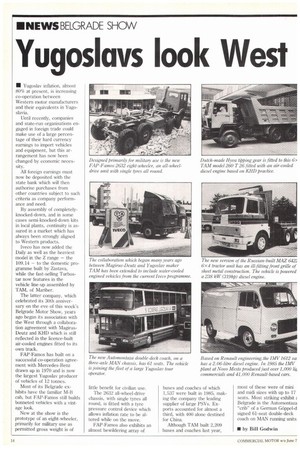Yugoslays look West
Page 14

If you've noticed an error in this article please click here to report it so we can fix it.
• Yugoslav inflation, almost 80% at present, is increasing co-operation between Western motor manufacturers and their equivalents in Yugoslavia.
Until recently, companies and state-run organisations engaged in foreign trade could make use of a large percentage of their hard currency earnings to import vehicles and equipment, but this arrangement has now been changed by economic necessity.
All foreign earnings must now be deposited with the state bank which will then authorise purchases from other countries subject to such criteria as company performance and need.
By assembly of completelyknocked-down, and in some cases semi-knocked-down kits in local plants, continuity is assured in a market which has always been strongly aligned to Western products.
Iveco has now added the Daily as well as the heaviest model in the Z range — the 109.14 — to the domestic programme built by Zastava, while the fast-selling Turbostar now features in the vehicle line-up assembled by TAM, of Mariber.
The latter company, which celebrated its 30th anniversary on the eve of this week's Belgrade Motor Show, years ago began its association with the West through a collaboration agreement with MagirusDeutz and KHD which is still reflected in the licence-built air-cooled engines fitted to its own truck.
FAP-Famos has built on a successful co-operation agreement with Mercedes-Benz drawn up in 1970 and is now the largest Yugoslav producer of vehicles of 12 tonnes.
Most of its Belgrade exhibits have the familiar M-B cab, but FAP-Famos still builds bonneted vehicles with a vintage look.
New at the show is the prototype of an eight-wheeler, primarily for military use as permitted gross weight is of little benefit for civilian use.
The 2632 all-wheel-drive chassis, with single tyres all round, is fitted with a tyre pressure control device which allows inflation rate to be altered while on the move.
FAP-Famos also exhibits an almost bewildering array of buses and coaches of which 1,537 were built in 1985, making the company the leading supplier of large PSVs. Exports accounted for almost a third, with 400 alone destined for China.
Although TAM built 2,209 buses and coaches last year, most of these were of mini and midi sizes with up to 17 seats. Most striking exhibit Belgrade is the Automontaza "crib" of a German Goppel-d signed 61-seat double-deck coach on MAN running units.
• by Bill Godwin




























































